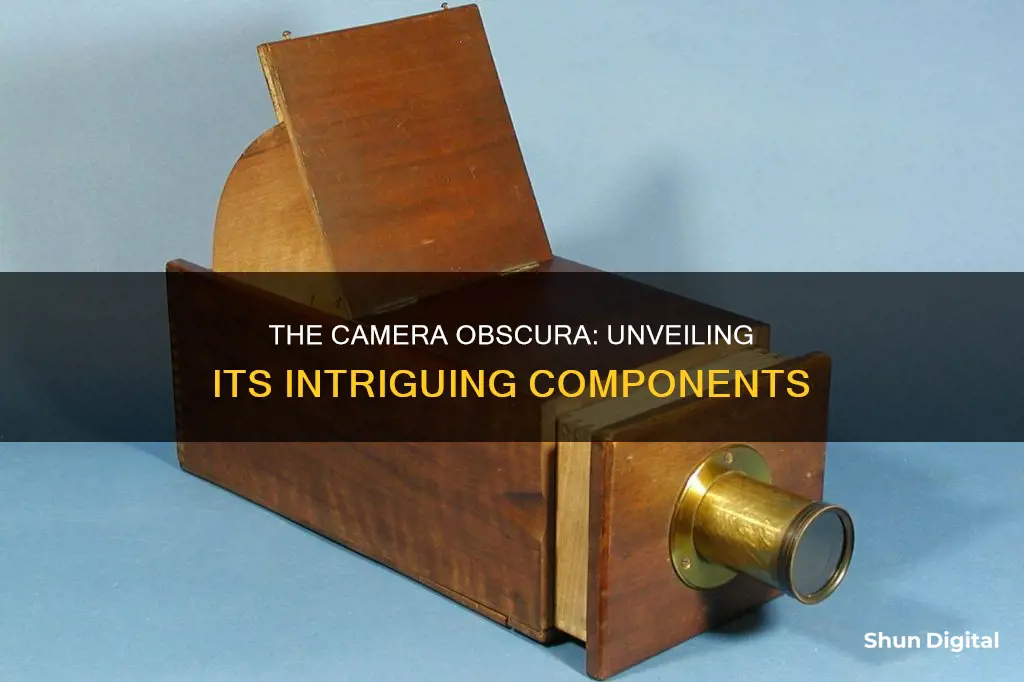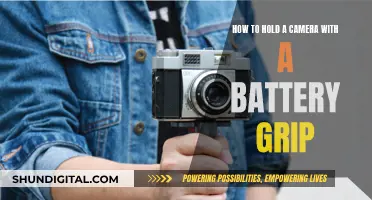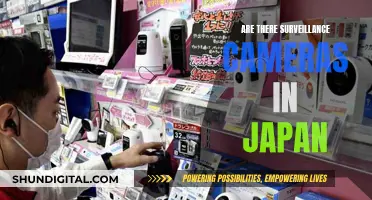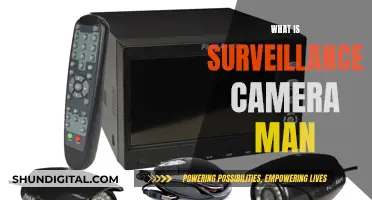
The camera obscura is an optical device and the ancestor of modern photography. In its simplest form, it is a dark room with a small hole in one wall, through which light enters and projects an upside-down image of the outside world onto the wall opposite the hole. The name camera obscura is Latin for dark chamber or dark room. The camera obscura was used as a drawing aid by artists, and as a tool to study eclipses without damaging the eyes by looking directly at the sun.
| Characteristics | Values |
|---|---|
| Definition | An optical device that is the ancestor of modern cameras |
| Name origin | From the Latin words "camera" (room) and "obscura" (dark) |
| Function | Captures the world by projecting what's on the outside down into a darkened space on the inside |
| Power source | None |
| History | Pinhole cameras have been around for several hundred years; camera obscuras have been in use since the second half of the 16th century |
| Use case | Used by artists as an aid for drawing and painting |
| Parts | A lens attached to an aperture on the side of a darkened tent or box |
What You'll Learn

The camera obscura is a natural phenomenon
The earliest versions of the camera obscura date back to antiquity and consisted of small darkened rooms with a single tiny hole, through which light entered and projected an upside-down image on the opposite wall. This phenomenon was observed and documented by ancient philosophers such as Mozi in China around 400 BC and Aristotle in Greece in the 4th century BC.
By the 11th century, a viewing screen was introduced to observe the inverted image, and the Arab scientist Alhazen (Ibn al-Haytham) is often credited with inventing the camera obscura. The phenomenon was also studied and described by various scientists and philosophers throughout history, including Leonardo da Vinci, who compared the human eye to a camera obscura.
In the 16th century, the camera obscura evolved into a portable device, with a lens attached to an aperture on the side of a darkened tent or box. This allowed artists to use it as an aid for drawing and painting, capturing the perspective and details of outdoor scenes. The benefits of the camera obscura for artists were noted by the Venetian nobleman Daniele Barbaro in 1568.
The term "camera obscura" was first used in 1604 by German mathematician, astronomer, and astrologer Johannes Kepler. Over time, the camera obscura was further developed, and portable box-like versions became popular among artists in the 17th and 18th centuries. Eventually, the camera obscura led to the development of photography when combined with light-sensitive materials.
Converting to Camera Raw: A Step-by-Step Guide
You may want to see also

It is an optical device
A camera obscura is an optical device and the ancestor of modern cameras. It is a Latin term that translates to "dark chamber". In its simplest form, it is a dark room with a small hole in one wall. When it is bright outside, light enters through the hole and projects an upside-down image of the outside world onto the wall opposite the hole.
The camera obscura is an optical device that creates an image by focusing rays of light onto a screen or sheet of paper. The light reflected by objects in the natural world enters the box through a lens set into the opening and projects an image onto the opposite surface. The image is formed by rays of light travelling in straight lines and is then reflected and partly absorbed by an object, retaining information about the colour and brightness of the surface of that object.
The camera obscura was originally developed as a scientific instrument but was also used by artists as an aid to drawing outdoors. The optical principles behind the camera obscura have been known since antiquity, but portable devices similar to the ones exhibited in museums were first available towards the end of the 16th century. The camera obscura was particularly useful for artists in rendering the correct perspective of views seen from eye level.
The box-type camera obscura often has an angled mirror projecting an upright image onto tracing paper placed on its glass top. The image is viewed from the back and is reversed by the mirror.
Labeling Camera Batteries: A Quick Guide to Best Practices
You may want to see also

It can be a room, a box or a tent
The camera obscura is a Latin term that means "dark chamber" or "dark room". It is an optical device that creates an image by focusing rays of light onto a screen or sheet of paper. The earliest versions of the camera obscura were small darkened rooms with light admitted through a single tiny hole.
Over time, the camera obscura evolved into a portable device, consisting of a tent or a box with a small opening on one side. This version of the camera obscura allowed artists to take it outdoors and use it as an aid for drawing and painting. The box-type camera obscura often had an angled mirror that projected an upright image onto tracing paper placed on its glass top. The image was viewed from the back and was reversed by the mirror.
The tent version of the camera obscura was used by Johannes Kepler in the early 17th century. He created a portable version that he carried around in a tent while surveying Upper Austria. This tent had an overhead version that used mirrors inside a periscope on top of the tent to project an upright image.
The box-type camera obscura became popular in the 17th and 18th centuries and was used by artists such as Vermeer and Canaletto. These portable boxes were often small enough to fit in a pocket and were painted black inside. The image was projected onto a screen or paper, and the artist could then trace the outlines of the scene.
The Brownie Hawkeye Camera: Bakelite Body?
You may want to see also

It can be used to study eclipses
A camera obscura is a Latin term that translates to "dark chamber". It is an optical device that creates an image by focusing rays of light onto a screen or sheet of paper. The device consists of a box, tent, or room with a small hole in one side or the top.
The camera obscura has been used to study eclipses without the risk of damaging the eyes by looking directly at the sun. The ancient technology can be made with household items such as a cardboard box, a sheet of white paper, scissors or a utility knife, and black spray paint. The inside of the box is painted black to create better contrast and absorb any errant light that gets in. A sheet of blank paper is then taped to one of the shorter ends of the box. The user then makes an aperture (the part of a camera that lets in light) by carefully poking a hole in the end of the box opposite the projection paper. The user then cuts out a roughly 1-inch square hole to look through, optimising the amount of light entering the box.
The camera obscura works similarly to the lens in the human eye, projecting images upside down on the retina, which are then flipped the right way around by the brain. This is why images within the box will appear upside down. The size of the aperture determines the sharpness and brightness of the projected image. The optimum sharpness is attained with an aperture diameter approximately equal to the geometric mean of the wavelength of light and the distance to the screen.
The camera obscura was used by ancient Greek philosopher Aristotle to observe a partial solar eclipse. He noted that the crescent shape of the sun during a partial eclipse could be viewed by looking at the ground beneath a tree, as the crescent-shaped sun was projected onto the ground through the gaps in the leaves. This allowed him to view the eclipse safely without damaging his eyes.
Capturing Pets: Best Camera Modes for Perfect Portraits
You may want to see also

It is the forerunner of the modern camera
The camera obscura is a forerunner of modern camera technology. The Latin term, which translates to "dark chamber", is an optical device that creates an image by allowing light to pass through a small hole or lens and projects it onto a screen or the opposite wall. This technique is the earliest known image projection method, dating back to the 4th century BCE.
The fundamental principles behind the camera obscura are still used in modern cameras. The main difference is that the camera obscura simply projected images, whereas modern cameras can capture them. The evolution of the camera obscura into the modern camera was made possible by the discovery that some materials are light-sensitive and can be used to preserve images.
The first photographic image was created in the early 19th century by Joseph Nicéphore Niépce using a camera obscura and a bitumen-coated pewter plate. This was followed by Louis-Jacques-Mandé Daguerre's invention of the Daguerreotype, which produced the first clear, sharp, and lasting photograph. The first commercial photographic camera was developed in 1839, marking the beginning of camera design and complexity advancements.
The camera obscura played a significant role in the development of modern photography. The concept of a dark chamber with a small aperture or lens to project images has been refined and improved over centuries, leading to the advanced camera technology we use today.
Supported File Formats for Camera Raw Explained
You may want to see also
Frequently asked questions
A camera obscura is made of a box, tent, or room with a small hole in one side or the top.
The hole in a camera obscura allows light from an external scene to pass through and strike a surface inside, creating an image.
A basic camera obscura consists of a dark room or box with a small hole or aperture, through which light enters and projects an image onto a surface inside.







